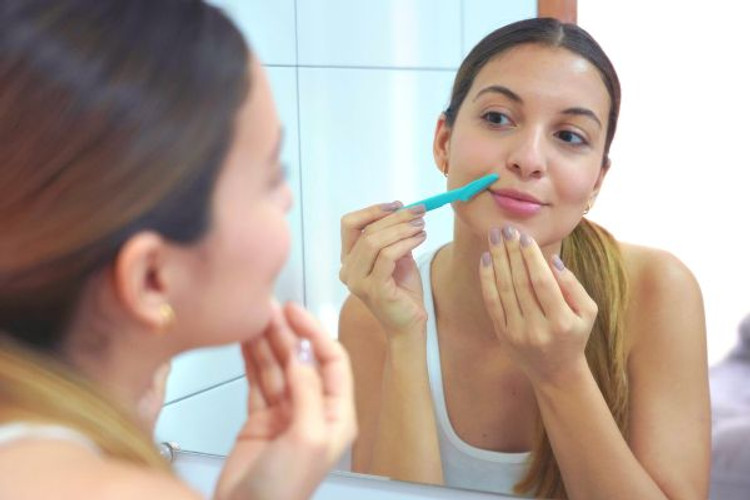Posted by YUNASENCE on 12th Nov 2023
Unlocking Radiance: The Art and Science of Dermaplaning
In the quest for smooth, radiant skin, dermaplaning has emerged as a popular and effective skincare procedure. This manual exfoliation technique has gained attention for its ability to leave the skin looking and feeling rejuvenated. Let's delve into the world of dermaplaning, exploring what it is, how it works, and the array of benefits it offers.
What is Dermaplaning?
Dermaplaning is a non-invasive exfoliation procedure that involves using a sterile surgical scalpel to gently scrape the surface of the skin. This manual exfoliation removes the outermost layer of dead skin cells and fine vellus hair, commonly known as "peach fuzz."
How Does Dermaplaning Work?
During the procedure, a trained skincare professional carefully glides the scalpel across the skin at a 45-degree angle. This precise technique exfoliates the epidermis, unveiling a smoother, brighter complexion. While the process may sound intimidating, it is painless and considered safe when performed by a skilled professional.
Benefits of Dermaplaning:
1. Smoothing Effect:
Dermaplaning instantly improves skin texture, leaving it soft and smooth. By removing the dead skin cells and fine hair, the skin's surface becomes more even.
2. Enhanced Product Absorption:
With the outer layer of dead skin cells removed, skincare products can penetrate the skin more effectively. This can enhance the efficacy of serums, moisturizers, and other treatments.
3. Brighter Complexion:
The exfoliation process helps to reveal fresh, healthy skin, leading to a brighter and more radiant complexion.
4. Fine Line Reduction:
Dermaplaning can minimize the appearance of fine lines and wrinkles, contributing to a more youthful-looking skin.
5. Hair Removal:
While not the primary purpose, dermaplaning effectively removes fine vellus hair, commonly referred to as peach fuzz.
Risks and Considerations:
While dermaplaning is generally safe, there are a few considerations:
1. Professional Expertise:
The procedure should be performed by a licensed and experienced skincare professional to ensure safety and optimal results.
2. Post-Treatment Sun Protection:
As with any exfoliation procedure, it's essential to protect the skin from the sun afterward. Sunscreen becomes crucial in preventing sun damage.
3. Avoid Active Acne:
Dermaplaning may not be suitable for those with active acne, as it could exacerbate the condition.
Dermaplaning stands out as a gentle yet effective method for achieving smoother, brighter skin. Its benefits extend beyond exfoliation, offering a range of advantages for those seeking a revitalized complexion. Before considering dermaplaning, it's advisable to consult with a skincare professional to determine if it aligns with your skin goals and concerns. Unlock the radiance within and embrace the journey to a more luminous, refreshed skin.
With the right tools and techniques, you can achieve the benefits of dermaplaning in the comfort of your home. Follow this step-by-step guide for a DIY dermaplaning session.
What You'll Need:
- Dermaplaning Tool or Razor: Choose a high-quality dermaplaning tool or a facial razor specifically designed for this purpose.
- Cleanser: Start with a gentle cleanser to remove any makeup, oil, or impurities from your skin.
- Toner: Use a toner to balance your skin's pH levels before starting the dermaplaning process.
- Mirror: Make sure you have good lighting and a mirror to see clearly during the process.
- Moisturizer: Have a hydrating moisturizer ready to apply post-dermaplaning.
Step-by-Step Guide:
1. Cleanse Your Skin:
Begin by cleansing your face thoroughly to ensure there's no makeup or impurities on your skin.
2. Pat Your Skin Dry:
Gently pat your skin dry with a clean towel. Avoid any harsh rubbing.
3. Apply Toner:
Swipe a toner across your face to balance the pH levels of your skin.
4. Stretch Your Skin:
Use your fingers to stretch your skin taut. This helps the dermaplaning tool glide smoothly.
5. Hold the Tool at a 45-Degree Angle:
Hold the dermaplaning tool or razor at a 45-degree angle and, using short, feathering strokes, move it across your face. Always move the blade in the direction of hair growth.
6. Take It Slow:
Dermaplaning is a gentle process. Take your time and don't apply too much pressure. Let the tool do the work.
7. Moisturize:
Once you've completed the dermaplaning process, apply a hydrating moisturizer to soothe the skin.
Tips for Safety:
- Ensure your hands and tools are clean.
- Avoid dermaplaning on irritated or sunburned skin.
- Don't share your dermaplaning tools to prevent the risk of infection.
DIY dermaplaning can be a safe and effective way to achieve smoother, radiant skin at home. By following these simple steps and exercising caution, you can enjoy the benefits of dermaplaning without leaving your home.

